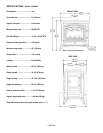
MAINTENANCE
PAGE 21
DO NOT CLEAN STOVE WHILE HOT
INSPECT THE ENTIRE STOVE FREQUENTLY FOR
PROPER OPERATION, FIT AND SOUNDNESS OF
PARTS. IF ANY MALFUNCTIONING, CRACKED, BRO-
KEN, OR LOOSE PARTS OR OTHER PROBLEMS ARE
NOTED, CONTACT YOUR DEALER OR QUALIFIED
SERVICEMAN TO INSPECT AND REPAIR THE UNIT.
DO NOT OPERATE THE UNIT IF INSTALLED OR
FUNCTIONING IMPROPERLY.
SUMMER SHUT DOWN
Remove ashes and cinders from the stove and dispose of
(see Ash Removal and Disposal on this page). If the room
is damp, place some absorbent crystals inside the stove
and/or disconnect it completely from the chimney. Close
doors and secure the latches closed.
CLEANING HEATER SURFACE
Clean the heater surface with a dry or slightly damp cloth.
In case of condensation, clean the affected areas before
they dry.
SMALL AREA PAINT TOUCH-UP
The stove body is painted with a quality high-temperature
stove paint. Use only Stove Paint, Catalog # 40M68. Do
not touch-up your stove with any other paint.
Using one small piece of 320 grit sand paper and lightly
sand the blemish so that the edges are “feathered” or
smooth to the touch between the painted and bare sur-
faces. Do not let the sand paper gum up with paint, as this
will cause scratches on the metal surface. If there are any
scratches, use 600 grit sandpaper instead. Mask off sur-
faces you do not want painted. Paint lightly over the bare
surface first as this will act as an undercoat. Then paint
over a larger area in smooth even strokes to blend.
See Break-In Period on page 17 for information on cur-
ing the paint.
ASH REMOVAL AND DISPOSAL
Empty the ash pan regularly to prevent the ash from spill-
ing over. Do not allow the ash to build up and touch the
under side of the grate.
To remove the ash from the stove, operate the firebox
grate using the handle.
A layer of ash left over the grate when burning wood will
protect the grate and retain heat so encouraging clean
combustion.
The tool provided for removal of the ash pan should
not be used to carry the ash pan. Use a leather glove
and hold the ash pan on both sides.
CAUTION: MAKE SURE THAT THE FIRE IS OUT AND
THE STOVE IS COLD BEFORE REMOVING ASHES!
Ashes can hold live embers for several days, and must be
disposed of with care.
NEVER place ashes in a cardboard box or any other com-
bustible receptacle.
Proper Disposal of Ashes:
Ashes should be placed in a metal container with a tight
fitting lid. The closed container of ashes should be placed
on a noncombustible floor or on the ground, well away
from all combustible materials, pending final disposal.
If the ashes are disposed of by burial in soil or otherwise
locally dispersed, they should be retained in the closed
container until all cinders have thoroughly cooled.
DOOR, AND GLASS GASKETS
If the gaskets which provide a seal around the doors or
glass should become frayed or damaged they should be
replaced with the same size and type as the original gas-
ket. Contact your dealer for ordering. Use high tempera-
ture silicone sealer as an adhesive for the door gasket.
The glass gasket has a self-adhesive backing (see Re-
placement Parts on pages 27-33). If the gasketing is in
good condition, check the closure latch screws; if these
are loose, tighten with a Phillips screwdriver (do not over-
tighten).
WARNING: THE GASKETS MUST BE KEPT IN GOOD
CONDITION. DO NOT LEAVE THE STOVE BURNING
WITH THE FUEL LOADING DOORS OPEN OR AJAR.
THIS WILL CAUSE EXCESSIVE HEAT BUILD UP IN
THE UNIT AND COULD IGNITE SURROUNDING
COMBUSTIBLES AS WELL AS DAMAGE THE
STOVE BY OVERFIRING IT. OVERFIRING IS A CON-
DITION WHERE EXCESSIVE TEMPERATURES ARE
REACHED, BEYOND THE DESIGN CAPABILITIES
OF THE STOVE (SUCH DAMAGE IS NOT COVERED
BY THE MANUFACTURERS WARRANTY).
FIREBRICK
The firebrick should be inspected periodically and replaced
if damaged (crumbling or excessively cracked). Through
normal wear and tear, the firebrick may need to be re-
placed over time (through proper installation, operation,
maintenance and fuel, the longevity of the firebrick will be
increased – see Overfiring Damage, page 24). For infor-
mation on warranty of the firebrick, see warranty statement
provided with the appliance.


















